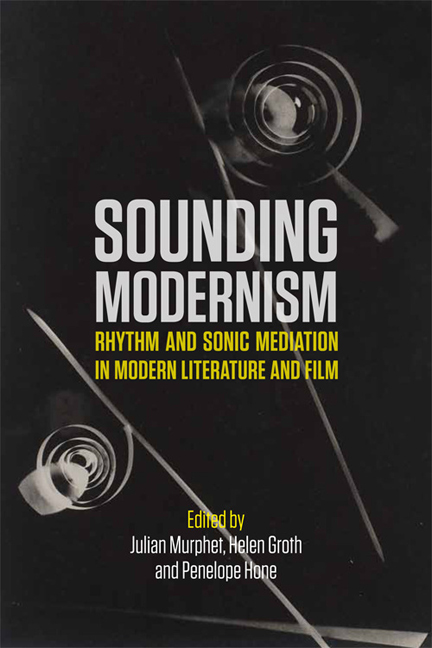Book contents
- Frontmatter
- Contents
- Acknowledgements
- 1 Introduction: Sounding Modernism 1890–1950
- Part One Writing Modern Sound
- Part Two Mediated Voices
- Part Three Difficult Voices
- Part Four Modern Rhythm: Writing, Sound, Cinema
- 12 The Rhythms of Character in Katherine Mansfield's ‘Miss Brill’
- 13 The Rhythm of the Rails: Sound and Locomotion
- 14 Two-step, Nerve-tap, Tanglefoot: Tapdance Typologies in Cinema
- Notes on Contributors
- Bibliography
- Index
13 - The Rhythm of the Rails: Sound and Locomotion
from Part Four - Modern Rhythm: Writing, Sound, Cinema
Published online by Cambridge University Press: 22 December 2017
- Frontmatter
- Contents
- Acknowledgements
- 1 Introduction: Sounding Modernism 1890–1950
- Part One Writing Modern Sound
- Part Two Mediated Voices
- Part Three Difficult Voices
- Part Four Modern Rhythm: Writing, Sound, Cinema
- 12 The Rhythms of Character in Katherine Mansfield's ‘Miss Brill’
- 13 The Rhythm of the Rails: Sound and Locomotion
- 14 Two-step, Nerve-tap, Tanglefoot: Tapdance Typologies in Cinema
- Notes on Contributors
- Bibliography
- Index
Summary
Rhythm-studies
Rhythm is the fundamental and vital quality of painting, as of all the arts – representation is secondary to that, and must never encroach on the more ultimate and fundamental demands of rhythm.
Roger FryThe critic John Middleton Murry, writing of his conversations with the Scottish painter J. D. Fergusson in the early decades of the twentieth century, recalled (in his autobiography Between Two Worlds):
One word was recurrent in all our strange discussions – the word ‘rhythm’. We never made any attempt to define it; nor ever took any precaution to discover whether it had the same significance for us both. All that mattered was that it had some meaning for each of us. Assuredly it was a very potent word.
For Fergusson [rhythm] was the essential quality in a painting or sculpture; and since it was at that moment that the Russian ballet first came to Western Europe for a season at the Châtelet, dancing was obviously linked, by rhythm, with the plastic arts. From that, it was but a short step to the position that rhythm was the distinctive element in all the arts, and that the real purpose of ‘this modern movement’ – a phrase frequent on Fergusson's lips – was to reassert the pre-eminence of rhythm.
In Fergusson's reported sentiments there is the suggestion that ‘this modern movement’ had come into being, or had found its true function, in the reassertion of ‘the pre-eminence of rhythm’. In this account, modernism rediscovers or recovers a rhythm, whose centrality, it is implied, had become submerged. Fergusson (in Murry's account) represents ‘rhythm’ as the ‘quality’ which cuts across the divisions between the arts, although the fact that they made no attempt to define the ‘quality’ leaves open the possibility (perceived by the more cautious Murry) that ‘rhythm’ in the various and different arts is to be understood as a homonym rather than as an identity.
The absence, or refusal, of strict ‘definition’ alluded to by Murry has as one of its contexts the vitalism (with its resistance to classification and differentiation) to which ‘rhythm’ was central, and which is part of that ‘great hymn to energy’, in Jacques Rancière's phrase, sung by artists and thinkers in the early twentieth century.
- Type
- Chapter
- Information
- Sounding ModernismRhythm and Sonic Mediation in Modern Literature and Film, pp. 193 - 210Publisher: Edinburgh University PressPrint publication year: 2017



